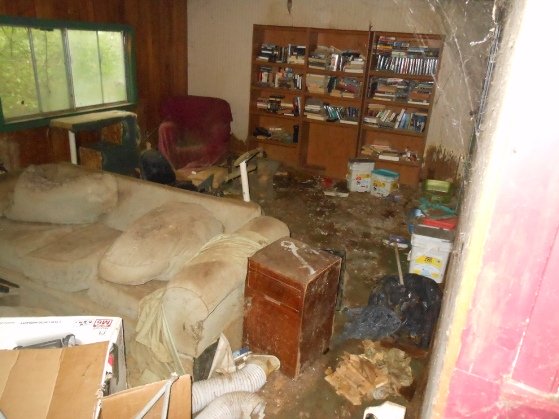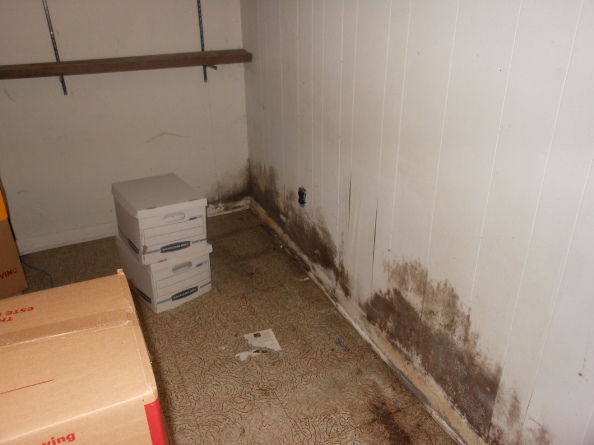Find a Mold Specialist Now
Click or Call, Toll-Free 24/7
Hoarding: Dangers, Cleanup, & Mold
Hoarding has come into greater public awareness in the last few years, thanks in part to television shows such as A&E’s “Hoarders” and TLC’s “Hoarding: Buried Alive”. It is estimated that hoarding, which includes the hoarders themselves and their families and friends, affect 1.4 million people in the U.S.
Hoarding is a type of obsessive-compulsive disorder (OCD). As the condition worsens, the hoarder’s mental, physical, and emotional health begins to suffer. Higher levels of anxiety and depression usually accompany hoarding. The hoarder’s relationships also suffer, as family and friends have a hard time coping with the hoarder’s eccentric mood swings.
Hoarders are accumulators. It may be food, paper, pets, or items of clothing, but whatever it is, hoarders feel an intense desire to “have” more of whatever it is they “collect”. The more they accumulate, the more isolated from society they become, and the worse their living conditions become. Everything they have accumulated is valuable to them and they become extremely agitated with anyone who suggests they should get rid of the “mess”.
What Are The Different Types Of Hoarding?
- Collectors – there is a very fine line between a collection of value and a collection of worthlessness. When emotions change from a sense of pride to one of embarrassment, things are on the verge of moving from a collection to a hoard.
- Animal Hoarders – this is when an individual has accumulated a large number of animals, beyond which they can provide the minimal standard of nutrition, shelter, and sanitation. The person usually thinks that they are doing a good deed, taking care of all the animals, but the opposite is usually true.
- Paper Hoarders – magazines, newspapers, books, mail, even food wrappers are the items a paper hoarder may “collect”.
- Food Hoarders – this is a tendency to buy or collect more food than a person can reasonably use. It can involve hiding, storing, or even stealing what the person can’t afford to buy.
 Animal hoarding cleanup
Animal hoarding cleanupWhat Are The Dangers of Hoarding?
Hoarding is not just a dangerous mental state, it can create an extremely dangerous environment to live in. The dangers can be somewhat unique depending upon what is being hoarded.
Most hoarders, if their tendency is not discovered sooner, will completely fill up a room or an entire house. This can seriously inhibit the hoarder’s ability to navigate throughout the home. Trip and fall hazards from all the clutter can become a deathtrap. Besides that, all the clutter can block airflow. Oxygen levels could fall and carbon dioxide levels can increase. This is especially true if clutter would fall on air vents, blocking cool air or heat.
With the lack of proper airflow in a home, mold may develop and not be able to be seen. People with allergies may develop breathing problems and not be aware of the cause.
Insect infestations can occur. Cockroaches and other types of insects may get out of control. The collection of hoarded objects will make it next to impossible for an exterminator to treat the problem.
With animal hoarders, feces and urine can cause serious dangers. Animal feces can spread airborne infectious bacteria. Urine can raise ammonia levels to dangerous levels. At just 300 parts per million, ammonia levels become life threatening. Parasites, bubonic plague, influenza, and rabies must also be considered.
Rodents such as mice and rats are attracted to the clutter. These animals bring bacteria, viruses such as Hantavirus, and various other diseases.
Hazards to Those Who Help
Going into a hoarding situation unprepared can cause serious injury to ordinary people just trying to help the hoarder. You face the same dangers as the hoarded. Trip and fall is the biggest danger. The clutter can also fall on you, trapping you. Even professionals have gotten into trouble while trying to provide lifesaving rescues.
Hoarding Cleanups
For the cleaning process, proper planning is the key. Your safety comes first, the hoarder’s safety second. If at all possible, the hoarder should be encouraged to leave the scene before any cleanup is started. Usually they are already stressed just thinking about someone else going through their stuff. To protect yourself, you must wear personal protection equipment. You should set up a negative air machine (a HEPA-rated air scrubber) to help clean the air while cleaning is underway. Tyvec suits and latex gloves worn inside work gloves are a must. You should consider eye protection and possibly even respirators (a dust mask does NOT provide adequate protection). The easiest entry points for diseases are the eyes, mouth and nasal passages. All items to be thrown away of should be bagged for disposal before being removed from the premises.
It is common in hoarding situations to come across water damage and mold. Water can destroy a floor’s integrity, which can lead to a floor collapsing under the weight of the cleaner. Mold spores can be released in the air with very minor degrees of air movement (slowly wave your hand in front of your face, that’s enough air movement to displace mold spores).
When you begin cleaning up a hoarding situation, you should always start cleaning closest to an exit point (a door, not a window). Then, carefully work your way into the rest of the room. In that way, you will always have an unobstructed exit lane in case some unexpected, dangerous event occurs. The last thing you need is to attempt to scramble to safety over the mess in an attempt to flee an emergency situation.
If mold has been discovered, it should be dealt with next. Mold is not a problem that should be tackled by an amateur. Mold is an organism, not dirt. Everyday cleansers and cleaning agents will not eliminate mold. Bleach is often recommended by the uneducated, but mold remediation specialists know that bleach will not be effective on porous materials, like drywall and wood. It is important to remember that mold must be first controlled, then captured, and then removed.
After the removal of all the clutter, cleaning is required. Sometimes the services of an exterminator and construction contractor may be required. A professional hoarding cleanup specialist understands the entire process required to return a home to a safe environment. Remember, the hoarding cleanup process can be dangerous and should be thoughtfully planned out before it is begun.
To contact a hoarding cleanup and mold remediation specialist near you, follow the link. All initial inspections are free of charge so there isn’t any reason to not take advantage of this offer.
Return From Hoarding Cleanup And Mold To Our Removal Guide
Written by Mark Huey.
Privacy Policy Terms and Conditions Accessibility Do Not Sell My Information Disclaimer Contact Us





